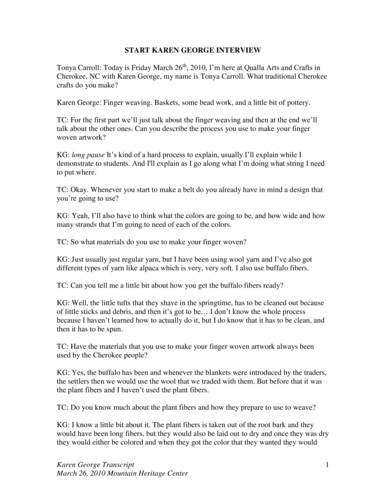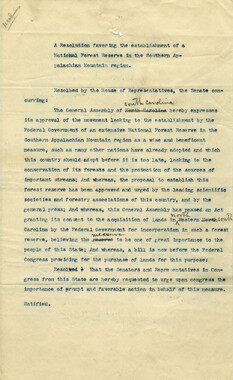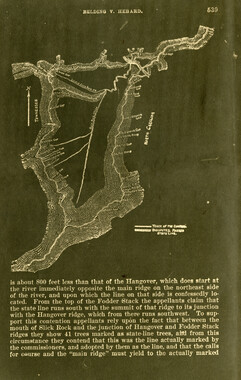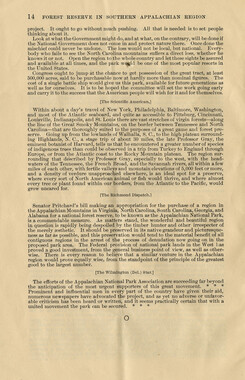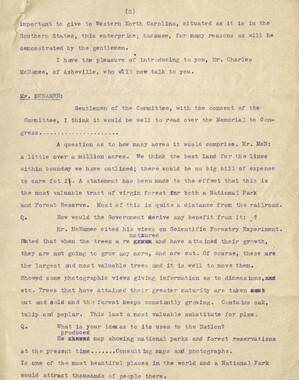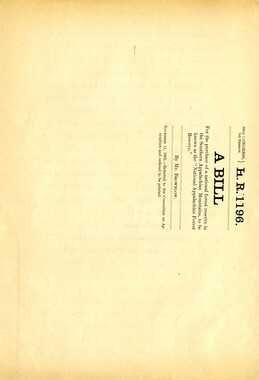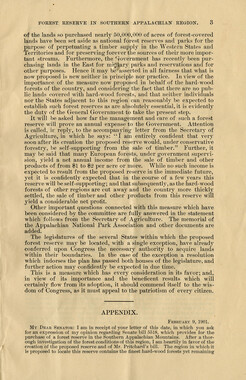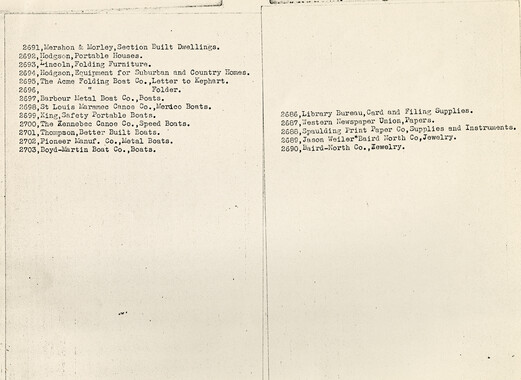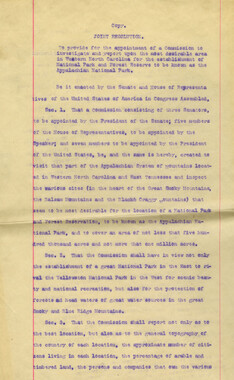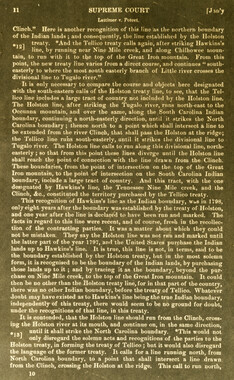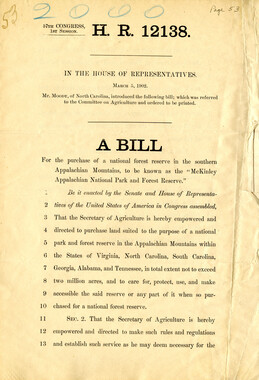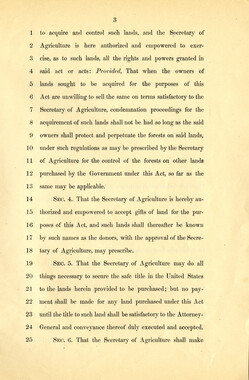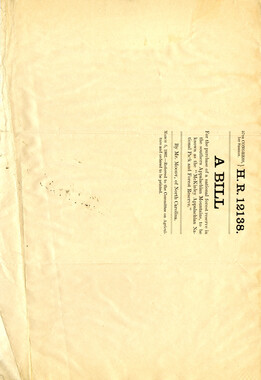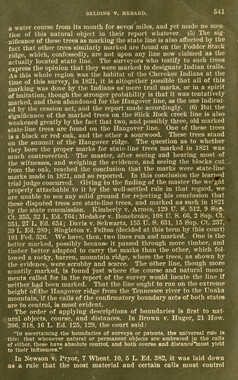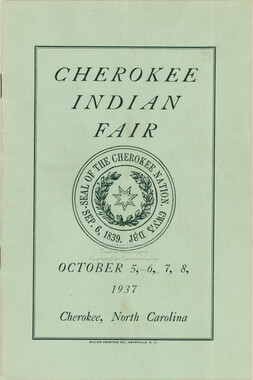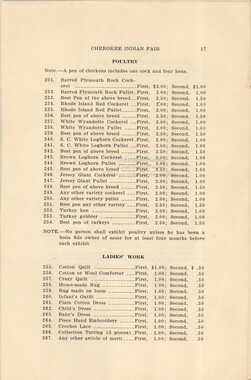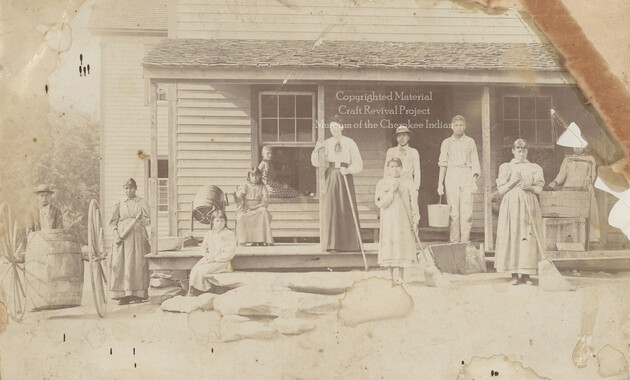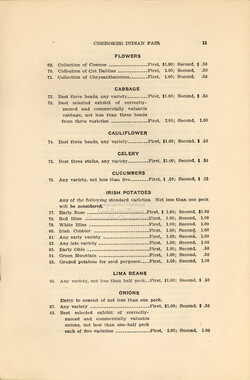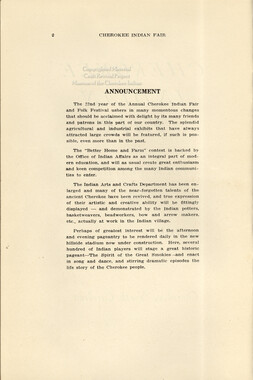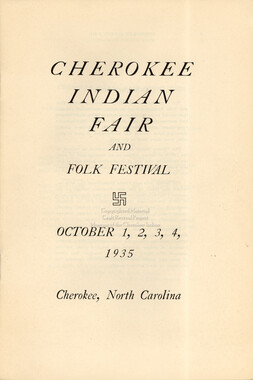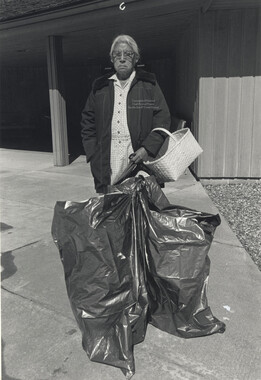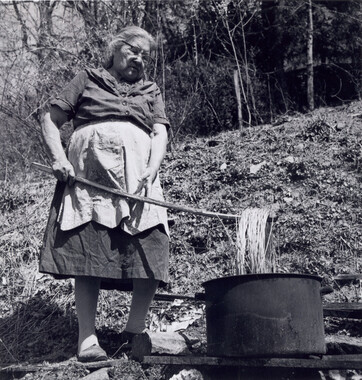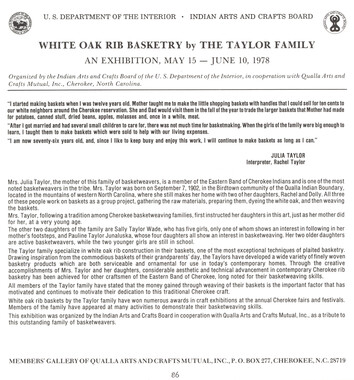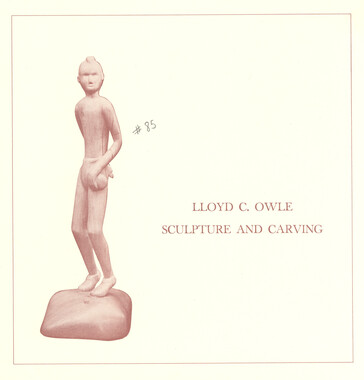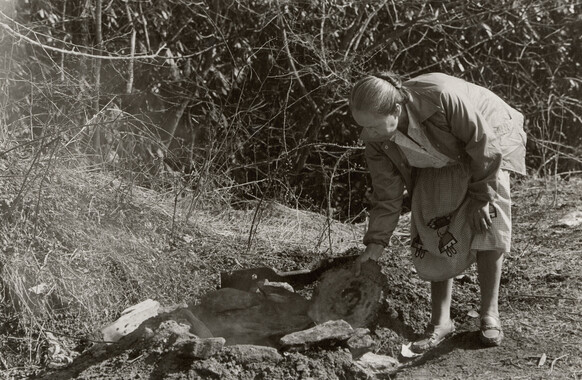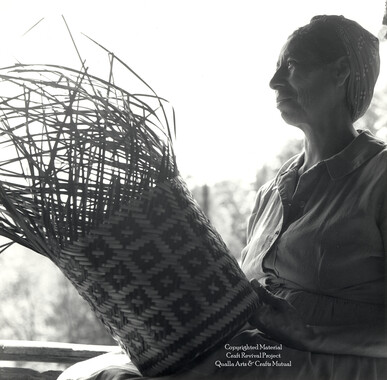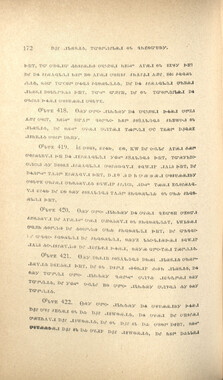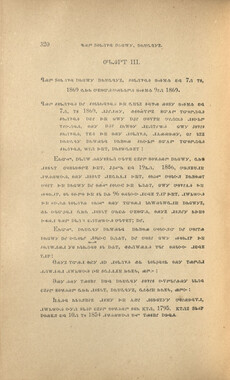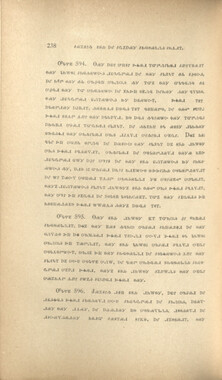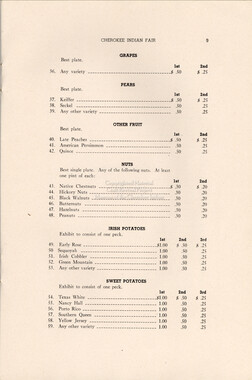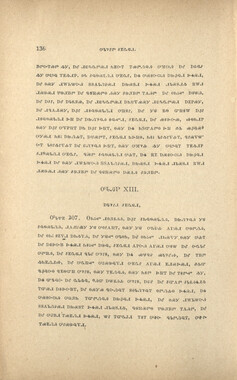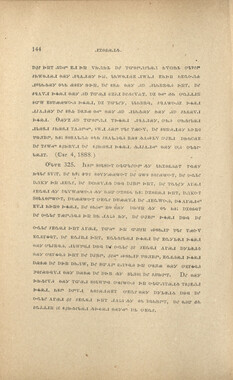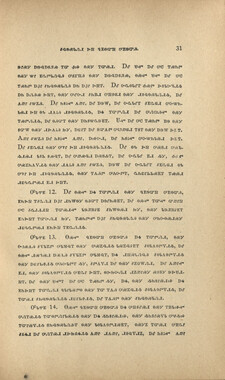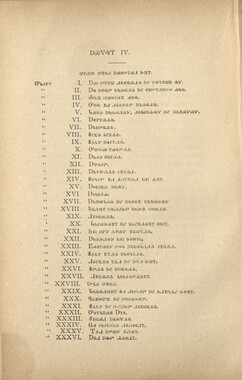Western Carolina University (20)
View all
- Canton Champion Fibre Company (2308)
- Cherokee Traditions (293)
- Civil War in Southern Appalachia (165)
- Craft Revival (1942)
- Great Smoky Mountains - A Park for America (2683)
- Highlights from Western Carolina University (430)
- Horace Kephart (941)
- Journeys Through Jackson (154)
- LGBTQIA+ Archive of Jackson County (15)
- Oral Histories of Western North Carolina (314)
- Picturing Appalachia (6679)
- Stories of Mountain Folk (413)
- Travel Western North Carolina (160)
- Western Carolina University Fine Art Museum Vitreograph Collection (129)
- Western Carolina University Herbarium (92)
- Western Carolina University: Making Memories (708)
- Western Carolina University Publications (2283)
- Western Carolina University Restricted Electronic Theses and Dissertations (146)
- Western North Carolina Regional Maps (71)
- World War II in Southern Appalachia (131)
University of North Carolina Asheville (6)
View all
- Cherokee Indian Fair Association (16)
- Cherokee Language Program (22)
- Roberts, Vivienne (15)
- Southern Highland Handicraft Guild (1)
- United States. Indian Arts and Crafts Board (65)
- Western Carolina University. Mountain Heritage Center (12)
- Allanstand Cottage Industries (0)
- Appalachian National Park Association (0)
- Bennett, Kelly, 1890-1974 (0)
- Berry, Walter (0)
- Brasstown Carvers (0)
- Cain, Doreyl Ammons (0)
- Carver, George Washington, 1864?-1943 (0)
- Cathey, Joseph, 1803-1874 (0)
- Champion Fibre Company (0)
- Champion Paper and Fibre Company (0)
- Crittenden, Lorraine (0)
- Crowe, Amanda (0)
- Edmonston, Thomas Benton, 1842-1907 (0)
- Ensley, A. L. (Abraham Lincoln), 1865-1948 (0)
- Fromer, Irving Rhodes, 1913-1994 (0)
- George Butz (BFS 1907) (0)
- Goodrich, Frances Louisa (0)
- Grant, George Alexander, 1891-1964 (0)
- Heard, Marian Gladys (0)
- Kephart, Calvin, 1883-1969 (0)
- Kephart, Horace, 1862-1931 (0)
- Kephart, Laura, 1862-1954 (0)
- Laney, Gideon Thomas, 1889-1976 (0)
- Masa, George, 1881-1933 (0)
- McElhinney, William Julian, 1896-1953 (0)
- Niggli, Josephina, 1910-1983 (0)
- North Carolina Park Commission (0)
- Osborne, Kezia Stradley (0)
- Owens, Samuel Robert, 1918-1995 (0)
- Penland Weavers and Potters (0)
- Rhodes, Judy (0)
- Roth, Albert, 1890-1974 (0)
- Schenck, Carl Alwin, 1868-1955 (0)
- Sherrill's Photography Studio (0)
- Smith, Edward Clark (0)
- Southern Highlanders, Inc. (0)
- Stalcup, Jesse Bryson (0)
- Stearns, I. K. (0)
- Thompson, James Edward, 1880-1976 (0)
- USFS (0)
- Vance, Zebulon Baird, 1830-1894 (0)
- Weaver, Zebulon, 1872-1948 (0)
- Western Carolina College (0)
- Western Carolina Teachers College (0)
- Western Carolina University (0)
- Whitman, Walt, 1819-1892 (0)
- Wilburn, Hiram Coleman, 1880-1967 (0)
- Williams, Isadora (0)
- 1800s (2)
- 1890s (6)
- 1900s (7)
- 1910s (1)
- 1920s (3)
- 1930s (13)
- 1940s (37)
- 1950s (12)
- 1960s (7)
- 1970s (38)
- 1980s (11)
- 1990s (2)
- 2000s (3)
- 2010s (38)
- 1600s (0)
- 1700s (0)
- 1810s (0)
- 1820s (0)
- 1830s (0)
- 1840s (0)
- 1850s (0)
- 1860s (0)
- 1870s (0)
- 1880s (0)
- 2020s (0)
- Appalachian Region, Southern (256)
- Buncombe County (N.C.) (2)
- Jackson County (N.C.) (1)
- Qualla Boundary (285)
- Asheville (N.C.) (0)
- Avery County (N.C.) (0)
- Blount County (Tenn.) (0)
- Cherokee County (N.C.) (0)
- Clay County (N.C.) (0)
- Graham County (N.C.) (0)
- Great Smoky Mountains National Park (N.C. and Tenn.) (0)
- Haywood County (N.C.) (0)
- Henderson County (N.C.) (0)
- Knox County (Tenn.) (0)
- Knoxville (Tenn.) (0)
- Lake Santeetlah (N.C.) (0)
- Macon County (N.C.) (0)
- Madison County (N.C.) (0)
- McDowell County (N.C.) (0)
- Mitchell County (N.C.) (0)
- Polk County (N.C.) (0)
- Rutherford County (N.C.) (0)
- Swain County (N.C.) (0)
- Transylvania County (N.C.) (0)
- Watauga County (N.C.) (0)
- Waynesville (N.C.) (0)
- Yancey County (N.C.) (0)
- Clippings (information Artifacts) (1)
- Fiction (general Genre) (3)
- Fliers (printed Matter) (3)
- Interviews (12)
- Newsletters (1)
- Photographs (208)
- Poetry (2)
- Publications (documents) (46)
- Sound Recordings (22)
- Video Recordings (physical Artifacts) (12)
- Aerial Photographs (0)
- Aerial Views (0)
- Albums (books) (0)
- Articles (0)
- Artifacts (object Genre) (0)
- Biography (general Genre) (0)
- Cards (information Artifacts) (0)
- Crafts (art Genres) (0)
- Depictions (visual Works) (0)
- Design Drawings (0)
- Drawings (visual Works) (0)
- Envelopes (0)
- Facsimiles (reproductions) (0)
- Financial Records (0)
- Glass Plate Negatives (0)
- Guidebooks (0)
- Internegatives (0)
- Land Surveys (0)
- Letters (correspondence) (0)
- Manuscripts (documents) (0)
- Maps (documents) (0)
- Memorandums (0)
- Minutes (administrative Records) (0)
- Negatives (photographs) (0)
- Newspapers (0)
- Occupation Currency (0)
- Paintings (visual Works) (0)
- Pen And Ink Drawings (0)
- Periodicals (0)
- Personal Narratives (0)
- Plans (maps) (0)
- Portraits (0)
- Postcards (0)
- Programs (documents) (0)
- Questionnaires (0)
- Scrapbooks (0)
- Sheet Music (0)
- Slides (photographs) (0)
- Specimens (0)
- Speeches (documents) (0)
- Text Messages (0)
- Tintypes (photographs) (0)
- Transcripts (0)
- Vitreographs (0)
- Cherokee Studies Collection (4)
- Horace Kephart Collection (1)
- Judaculla Rock project (2)
- Qualla Arts and Crafts Mutual Collection (12)
- A.L. Ensley Collection (0)
- Appalachian Industrial School Records (0)
- Appalachian National Park Association Records (0)
- Axley-Meroney Collection (0)
- Bayard Wootten Photograph Collection (0)
- Bethel Rural Community Organization Collection (0)
- Blumer Collection (0)
- C.W. Slagle Collection (0)
- Canton Area Historical Museum (0)
- Carlos C. Campbell Collection (0)
- Cataloochee History Project (0)
- Daisy Dame Photograph Album (0)
- Daniel Boone VI Collection (0)
- Doris Ulmann Photograph Collection (0)
- Elizabeth H. Lasley Collection (0)
- Elizabeth Woolworth Szold Fleharty Collection (0)
- Frank Fry Collection (0)
- George Masa Collection (0)
- Gideon Laney Collection (0)
- Hazel Scarborough Collection (0)
- Hiram C. Wilburn Papers (0)
- Historic Photographs Collection (0)
- Humbard Collection (0)
- Hunter and Weaver Families Collection (0)
- I. D. Blumenthal Collection (0)
- Isadora Williams Collection (0)
- Jesse Bryson Stalcup Collection (0)
- Jim Thompson Collection (0)
- John B. Battle Collection (0)
- John C. Campbell Folk School Records (0)
- John Parris Collection (0)
- Kelly Bennett Collection (0)
- Love Family Papers (0)
- Major Wiley Parris Civil War Letters (0)
- Map Collection (0)
- McFee-Misemer Civil War Letters (0)
- Mountain Heritage Center Collection (0)
- Norburn - Robertson - Thomson Families Collection (0)
- Pauline Hood Collection (0)
- Pre-Guild Collection (0)
- R.A. Romanes Collection (0)
- Rosser H. Taylor Collection (0)
- Samuel Robert Owens Collection (0)
- Sara Madison Collection (0)
- Sherrill Studio Photo Collection (0)
- Smoky Mountains Hiking Club Collection (0)
- Stories of Mountain Folk - Radio Programs (0)
- The Reporter, Western Carolina University (0)
- Venoy and Elizabeth Reed Collection (0)
- WCU Gender and Sexuality Oral History Project (0)
- WCU Mountain Heritage Center Oral Histories (0)
- WCU Oral History Collection - Mountain People, Mountain Lives (0)
- WCU Students Newspapers Collection (0)
- Western North Carolina Tomorrow Black Oral History Project (0)
- William Williams Stringfield Collection (0)
- Zebulon Weaver Collection (0)
- Artisans (125)
- Cherokee art (18)
- Cherokee artists -- North Carolina (10)
- Cherokee language (21)
- Cherokee pottery (27)
- Cherokee women (140)
- Civilian Conservation Corps (U.S.) (1)
- Forced removal, 1813-1903 (1)
- Storytelling (5)
- Weaving -- Appalachian Region, Southern (1)
- Wood-carving -- Appalachian Region, Southern (14)
- African Americans (0)
- Appalachian Trail (0)
- Church buildings (0)
- College student newspapers and periodicals (0)
- Dams (0)
- Dance (0)
- Education (0)
- Floods (0)
- Folk music (0)
- Forest conservation (0)
- Forests and forestry (0)
- Gender nonconformity (0)
- Great Smoky Mountains National Park (N.C. and Tenn.) (0)
- Hunting (0)
- Landscape photography (0)
- Logging (0)
- Maps (0)
- Mines and mineral resources (0)
- North Carolina -- Maps (0)
- Paper industry (0)
- Postcards (0)
- Pottery (0)
- Railroad trains (0)
- Rural electrification -- North Carolina, Western (0)
- School integration -- Southern States (0)
- Segregation -- North Carolina, Western (0)
- Slavery (0)
- Sports (0)
- Waterfalls -- Great Smoky Mountains (N.C. and Tenn.) (0)
- World War, 1939-1945 (0)
Karen George: Cherokee Artist and Weaver
Item
Item’s are ‘child’ level descriptions to ‘parent’ objects, (e.g. one page of a whole book).
-
-
Karen George Transcript March 26, 2010 Mountain Heritage Center 1 START KAREN GEORGE INTERVIEW Tonya Carroll: Today is Friday March 26th, 2010, I’m here at Qualla Arts and Crafts in Cherokee, NC with Karen George, my name is Tonya Carroll. What traditional Cherokee crafts do you make? Karen George: Finger weaving. Baskets, some bead work, and a little bit of pottery. TC: For the first part we’ll just talk about the finger weaving and then at the end we’ll talk about the other ones. Can you describe the process you use to make your finger woven artwork? KG: long pause It’s kind of a hard process to explain, usually I’ll explain while I demonstrate to students. And I'll explain as I go along what I’m doing what string I need to put where. TC: Okay. Whenever you start to make a belt do you already have in mind a design that you’re going to use? KG: Yeah, I’ll also have to think what the colors are going to be, and how wide and how many strands that I’m going to need of each of the colors. TC: So what materials do you use to make your finger woven? KG: Just usually just regular yarn, but I have been using wool yarn and I’ve also got different types of yarn like alpaca which is very, very soft. I also use buffalo fibers. TC: Can you tell me a little bit about how you get the buffalo fibers ready? KG: Well, the little tufts that they shave in the springtime, has to be cleaned out because of little sticks and debris, and then it’s got to be… I don’t know the whole process because I haven’t learned how to actually do it, but I do know that it has to be clean, and then it has to be spun. TC: Have the materials that you use to make your finger woven artwork always been used by the Cherokee people? KG: Yes, the buffalo has been and whenever the blankets were introduced by the traders, the settlers then we would use the wool that we traded with them. But before that it was the plant fibers and I haven’t used the plant fibers. TC: Do you know much about the plant fibers and how they prepare to use to weave? KG: I know a little bit about it. The plant fibers is taken out of the root bark and they would have been long fibers, but they would also be laid out to dry and once they was dry they would either be colored and when they got the color that they wanted they would Karen George Transcript March 26, 2010 Mountain Heritage Center 2 then let them dry again, then they would prepare to weave with them. So it’s a long process. TC: Do you know what colors they had or how they got the colors on the plant fibers? KG: It was usually the same colors that we use on our baskets. Bloodroot, butternut, yellow root. TC: So how long would the process take for you to make a belt say for just the average size person? KG: It would take anywhere from, working on it constantly would be about a week and a half, but just taking my time it could last a couple of months. TC: How did you learn how to do the finger weaving? KG: I learned how to do the finger weaving in school, because it’s taught in our schools. But I didn’t learn that much then when I started working at the Indian Village I learned a great deal and that’s just the regular finger weaving. But with the beads then, this lady from she’s a collection’s manager from Carnegie museum. She came down and she taught a class so that’s how I learned. TC: Why did you become interested in learning how to finger weave? KG: It was something I could carry with me wherever I went. It didn’t take up a lot of room. The materials at the time were easy to get, which was regular yarn. So and I’ve always liked to do it anyway. TC: So how long have you been finger weaving? KG: I first learned when I was like 15 years old I believe. So it’s been quite awhile. TC: Can you tell me a little bit about the designs that you use? KG: There’s several designs, the easiest one is called plant design and it’s just a plant. And then we’ve go the Chevron, and then Eagle Dancer, Diamond, and there’s also [Sewell] weave and it’s just a plaid or a check design. And then with the beads there is Diamond Design, and there’s just a whole variety a much wider variety of designs with beads in it. And there are things that you can come up with also. TC: So how do you get the designs? KG: It’s all how you set the yarns up, the different colors. You have to set them up a certain way to get a certain design. TC: So when you learn how to finger weave do you have to learn each individual design? Karen George Transcript March 26, 2010 Mountain Heritage Center 3 KG: Yeah. TC: Will you say it. KG: Yeah, yeah, you have to learn each individual design, because there’s a little bit of the technique in each of the, the harder designs. TC: Have you made up any designs on your own? KG: I’ve made a few mistakes and they came out different. TC: Well in your opinion what is the most difficult design? KG: The Diamond Design. I haven’t got that here, but the diamond design. It’s a lot difficult because you’ve got, you’re working not only from top to bottom, but halfway in the design, you’re switching and working in a different direction. TC: Have you or are you passing finger weaving onto a younger generation? KG: Hopefully. Actually my son has learned to do a little bit and we have had classes, we have classes, but what they do with it after they have the class that’s… hopefully they’ll keep on it. TC: Have you noticed, finger weaving, or making finger weaving change over time since you’ve been doing it? KG: Yeah, I’ve noticed people are more interested in it now than when I first started. TC: Do you remember the first time that you finished your first finger weaving piece? KG: Yeah, I think so, it wasn’t a very long piece and it wasn’t the straightest thing. But I was I was happy. TC: Can you talk a little bit about how you set it up. Do you use a loom, is it free hand? KG: No looms are ever used, it’s all done by hand and I will just take the string and at my house I’ve got three nails in my wall and they’re long nails, but I’ll start off at one end and go around to the length I want. And then keep on going. And then I’ll get the amount that I want, take that off and start with a different color and do the same thing. And that’s how I get my belts strung up. But each person’s got different ways to do it. TC: So you don’t really use a tape measure or anything like that? KG: I use a tape measure to measure off how long or what nail I need to use. So once I got that I’ll add an extra to it. Then I’ll start working with the yarn. Karen George Transcript March 26, 2010 Mountain Heritage Center 4 TC: What is the most skein of yarn you’ve worked with? KG: I’d have to say about I’ve used a whole skein of yarn, a bigger, not a small one, but the next bigger size, I’ve used every bit of it and I think there was like a maybe a 100 no about there was close to about 300 strands on that. TC: So about how wide would that make it? KG: It was about that wide. Gesturing with hands about 10 inches wid. TC: Do you remember how you felt the first time that someone paid you or traded you for some of your finger weaving? KG: Yeah, I was surprised and happy. TC: Say somebody bought one of your belts and ten years from now, if you saw it would you be able to know that it’s yours? KG: Yes. TC: Can you tell me how you would recognize that it is yours? KG: Well each person does the weave a little bit different than the other and at the very end on the fringes each person does different also. And I know what mine look like. TC: Can you explain the importance to Cherokee culture to keep finger weaving alive why you think it’s important? KG: It was used as clothing before any contact with the explorers, so it’s been around for a long time. And it’s… it’s an art that you can’t really, I don’t think we should ever loose. TC: Did you or when did you realize that you are a keeper of Cherokee tradition? KG: I guess whenever I was at the Indian village we started learning more and more about the accurate history and I think that’s when I did. TC: Since you are a Cherokee tradition keeper, do you feel any obligation to teach other people or teach classes and share your knowledge? KG: Yeah, I will anybody needs any help, I’m always glad to help them. If they want to learn, I’m willing to teach. TC: How does it make you feel that other Cherokee people look up to you, or look up to you because you have that knowledge? KG: It feels good. Karen George Transcript March 26, 2010 Mountain Heritage Center 5 TC: Would you say that, they’re going to cut me out. How it makes you feel that the Cherokee people look to you because you know how to make the finger weaving? KG: It makes me feel great to know that other people would look to me to, what was that again? TC: It’s okay. We can edit it. That other people look up to you because you have this knowledge? KG: Ohhh, it’s not memory. TC: It’s not the same thing. KG: I’ll try it again. It makes me feel great to know that other people would look up to me like where I have all this knowledge. TC: Are you worried that your artwork, that the type of artwork that you do is going to die out? KG: No, not really because a lot more people are wanting to do the work with beads in it now. And so maybe, maybe in a matter of 5 years there will be more than just me knowing how to do the ones with the beads. TC: Can you talk about when they started using the beads, or why they use the beads or anything about the history of it. KG: We started using the beads whenever we started trading for you know they brought the beads in so we started adding the beads to our weavings and along with that they also brought in wool yarns that we didn’t have to, we didn’t have or we didn’t have to spin our self. And the wool was lot, well I wouldn’t say a lot easier to use, it was probably a lot easier to get because they would have already spun it. and that had a lot, we didn’t have to go out and get the fibers and dry them and color them. TC: Is there any significance to the types of designs or the colors that were used. KG: Most of them are red, blue, maybe dark blue and black. And the beads were always white. The red and the black were symbolized the war and that’s a lot of the warriors would wear the belts. And they were also used for sashes to carry their pouches or the fire pots. TC: Did the women wear the belts? KG: We have tried to find out and we don’t really know for sure if they have, and I’m thinking if somebody is going to make something they’re going to wear it themselves too, Karen George Transcript March 26, 2010 Mountain Heritage Center 6 but there’s no mention in the history of the women wearing belts, just the men. But I would think they would want to look good too. TC: So traditionally was it the women who would do the weaving? KG: Yes, but I think mostly, now if there is a single man, and he’s wanting a belt he’s going to have to either do it himself or get his sister to make it for him. And if she’s got a husband, she’s going to be busy making stuff for him. TC: Do you make any other Cherokee crafts or carry on any other Cherokee traditions? KG: I’ve learned basket making while I was I have been employed with the Indian Village. I’ve worked with white oak, maple, honeysuckle and river cane. The river cane is the hardest though. And I also have done a little bit of bead work and a little bit of pottery. TC: Were these all crafts that you learned at the Indian Village? KG: Well the majority of them. The baskets and the pottery at the Indian Village. Bead work I kind of knew how to do, I mean the finger weaving. TC: Well it sounds like you just know how to do a little bit of everything. So which one is your favorite to work with? KG: It depends on what type of mood I’m in. Sometimes finger weaving is my favorite, but if I get a basket started, then that’s what I’m concentrating on. I won’t do anything else but that until I finish it. But I would have to say all in all my favorite is the finger weaving. TC: I also know that you perform Cherokee social dances through your employment at the Indian village, can you tell me a little bit about that? KG: About a couple years ago we started doing the traditional dances at the Indian Village, the employees. At first it was hard to get anybody to come in and to go up there and dance, but then, last year everybody was wanting to. But it’s really fun, we have a really great time when we are doing those and it’s just what it is a social dance and we’re having a good time. TC: So what are some of the dances that you perform? KG: We do bear dance, quail, the beaver dance, let’s see horse dance, let’s see, there’s another one I can’t remember. And there’s also a friendship dance which anyone that’s sitting in there while they are watching us, they can come out and participate. TC: Were these types of dances always done by the Cherokee? Karen George Transcript March 26, 2010 Mountain Heritage Center 7 KG: Yes, they were. Each dance is to give thanks to that specific animal like the quail and the bear we give thanks to the bear for giving himself to us to feed us and for the use of his fur. TC: What about the corn? KG: Oh yeah, the corn dance. TC: Can you tell me why they do the corn dance? KG: It’s to the Mother Earth for the corn, for letting corn grow, and it’s also… it honors, honors the I guess the Mother. TC: I know that recently you’ve been traveling and demonstrating and talking to people about Cherokee arts and culture, and can you just tell me about the places that you’ve gone and what you do. KG: Well, recently we’ve went to colonial Williamsburg, and we’ve all… most of them didn’t know that the Indian village existed so we would tell them everything. And they are dressed in the same time period that we are and that kind of you kind of get ideas like how they act and how we react because they’ve got a history. Cherokees have a history of going to Williamsburg and spending months at a time. And there’s actual artifacts they’ve got up there that are Cherokee and we got to go to the archives to look at them. TC: Do you have any questions? David Brewin: Um let’s see, I had one a minute ago, let me put a battery in this thing and then I can walk over there when Karen is working on her stuff. TC: That’s alright, no questions. DB: Do you have anything that you want to add? KG: I don’t think so. DB: Oh yeah, the question I’m wondering when you said pre contact times that this process is used for clothing. Could you describe the type of clothes that would be done using this technique. KG: It would have been like a cloth type and they would have just like wrapped it around. It would have just been a big old cloth type material. The mulberry root bark and dried inner fibers of the Indian Hemp plant. And that would have been some of the early explorer days compared those fibers to linen. They was woven so fine and I can just imagine how much work it took just to get a big old piece of cloth. DB: Especially something that would be reasonably comfortable to wear. Karen George Transcript March 26, 2010 Mountain Heritage Center 8 KG: Yeah. Yeah. DB: Never knew that. TC: Okay, I’ll let him END OF KAREN GEORGE INTERVIEW START OF INTERVIEW WITH KAREN GEORGE INSIDE INDIAN VILLAGE Karen: Something like that or first of part of, first week in June, or sometime, or the first of June, but it doesn’t start until then. David Brewin: Do you all have a drummer and stuff like that? Karen: Yep we do. He’s just 21 but he has got a very good singing voice and he’s also in the drama. DB: I want to see that drama again, I saw it when I was 5 years old, but I think that was about one of the first years that’s when it really got started back in the 50’s. Haven’t seen it since then. Basket Maker: Are you evening it out, is that what you’re doing? Karen: Yeah, just on the sides. She is holding a piece of fiber in her hand and with a knife shaving the sides off little by little. DB: You are doing what Karen? Karen: I’m trimming the sides down, I’m making them even. DB: Okay. BM: I don’t believe I’m doing a very good job of it Karen, I can’t tell [laugh] Karen: Just hold it out and look at it and you can see where it needs to be trimmed down, so you’ll go to that spot and just barely put pressure on the side of it and take just a sliver off. Holds it up to see, but the sides are barely uneven. DB: Those are old baskets right? Showing a yellow in color, diagonally woven basket with design. Karen George Transcript March 26, 2010 Mountain Heritage Center 9 Karen: Yeah, they’ve been here awhile. Now where are you from? DB: Western Carolina University, don’t hold that against me. I’m recording myself I better… All: [laugh] DB: Do you know the history of any of these baskets here? Karen: Like who made them? DB: Yeah, they’ve just been here ever since forever. Showing basket that is woven with off white and gray color in vertical and horizontal lines. Has two handles at the top. Karen: Yeah, they have as long as I’ve been working up here. DB: They look pretty old. Karen: And that’s been since ’96 was my first year. DB: Wow. Karen: So they’ve been here since then. [laugh] Now the only thing we do have [new], we still have to get the yellow root and the blood root and change them, freshen them up every year, or actually two times a year. And then these are [new]. DB: Are you dying out here too, is that part of it? Karen: Yeah, we’ll dye, there’s a big ol’ tub out here, so we’ll build a fire back there in that shelter. Pointing back behind her. And then we’ll put everything that we need in there and boil it for a few days. DB: You have to boil it for a few days. I notice those are kind of narrow there that you’re soaking in the water. Is that like a band for the top of the basket? Karen: No, I’m going to make a double weave and it’s going to be a small one. Holding very narrow strands of fiber. And that’s what these are. I’ve got to cut these in half again Showing strands that are a little large to make them this thin and then I’m going to cut these in half this way. So the little, it’s going to be a small basket. DB: How long do you reckon it’ll take you to do that? Karen: Cutting all this down, maybe I should be done by at least tomorrow sometime. DB: And then you’ll be ready to start weaving tomorrow then. Karen George Transcript March 26, 2010 Mountain Heritage Center 10 Karen: Lay these out. BM: Ask me. DB: I’m going to right now. BM: No. [laugh] Don’t ask me anything cause I really don’t know, I’m just being a smart aleck. Another woman is sitting beside Karen also trimming the sides of the fibers with a knife to even it out. DB: How long have you all been working here? BM: Just this year, yeah. I’m a rookie. I’m learning how to do baskets and trimming and that’s about it. My mother was a basket weaver though. But I just never learned. DB: So now you’re going to. That’s great. BM: At the ripe age of 66 years old. DB: You and I are close to the same age. Nice to find seniors out. I want to take a pottery class over here, is what I want to do. BM: Yes DB: Talked to Joel about it. BM: Yeah, well he’d be the one to teach you. DB: Well this is a great job, at least right now you don’t have a lot of tourists, have a little peace and quiet. Camera on fireplace made of stone with fire going near them. Fire felt good this morning didn’t it. BM: It did. Karen: It was cold. Man walks up and introduces the ladies in Cherokee and shows a group of children what they are doing all the while describing it and the things around in Cherokee. Holding up baskets and tools and fibers. The children repeat him. DB: Is that the immersion school? Karen: Mhmm. DB: Oh that’s great. Karen George Transcript March 26, 2010 Mountain Heritage Center 11 BM: I love to hear it. Karen: I should have let him go behind me. END OF INTERVIEW WITH KAREN
Object
Object’s are ‘parent’ level descriptions to ‘children’ items, (e.g. a book with pages).
-
In this video interview, Karen George, a Cherokee artist known for her doubleweave baskets and beaded finger weaving, explains how she puts a part of herself in each piece that she makes. Particularly her woven belts are popular among men who dance. The transcript provided is an unedited version of the video.
-
